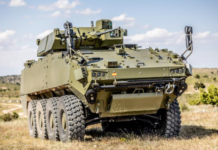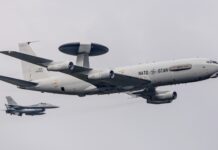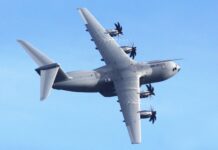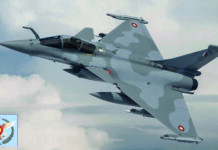Platforms to fulfil the heaviest load-carrying demands can be counted on one hand. When not counting the medium category of an AW/EH-101 or NH-90 below 15 tonnes MTOW, there are just two or three Western types, plus one upcoming Eastern type. In light of the ongoing tender for the German Bundeswehr’s heavy-lift helicopter requirement, this article takes a further look at who is really lifting out there.
Finally, the German government has taken another step forward to replace its ageing fleet of CH-53 heavy transport helicopters. On 28 February 2019, the German procurement authority BAIINBw published the performance and programme details for the Schwerer Transporthubschrauber (STH) requirement. They want to procure 44 to 60 heavy helicopters for the Luftwaffe over an eight-year delivery period. After approving the budget of up to €5.6Bn for the STH programme in November 2018, the German government remarked that the Boeing CH-47F CHINOOK and Sikorsky’s CH-53K KING STALLION would “appear to be appropriate” to replace the 70 incumbent Sikorsky CH-53G/GS/GA/GEs. The (two) interested parties responded by 14 May to the release of the tender documents. A request for proposals (RFP) will be issued shortly, followed by a type selection in 2020 and aircraft deliveries from 2023 onwards. The helicopters will be based in Schönewalde/Holzdorf near Berlin and Laupheim near Ulm.
According to the tender documents, the future helicopter should be capable of transporting personnel and equipment/vehicles and have a maximum take-off weight (MTOW) of 20+ tonnes. With such a load, the helicopter has to achieve a minimum speed of 120 KTAS (~220 km/h) at International Standard Atmosphere. With regard to the lifting capability requirements, the tender specifies 30 soldiers with equipment of 115 kg each, or 10 tonnes of cargo either stored internally or underslung externally. Another “must” is the transport of eight tonnes of internal cargo over a distance of 230 km. Winch sets, ballistic protection, an ElOp/IR sensor and self-defence arrangements are also listed. Procurement includes mission systems, logistics and operational support, including the necessary equipment as well as technical and flight training.
Referring to the RFP, Frank Crisafulli, Business Development Manager for heavy-lift helicopters at Sikorsky, said that the delay of the 2019 defence budget approval by the Bundestag budget committee (earlier in the same month) should have no real knock-on effect on the timeline for the STH programme for the Luftwaffe: “We are very happy about the approval after all the budget drama. The Germans have compressed the timeline but the planned delivery dates remain the same. They are looking for between 45 and 60 helicopters from late 2023 or very early 2024.” German Luftwaffe Chief of Staff LtGen Ingo Gerhartz has also welcomed the budget allocation for the new helicopter: “This will help to advance the urgently needed modernisation of the air force.”
Secure for the Moment
In the end, procurement will be dependent on the budget plan of the Social Democratic Finance Minister Olaf Scholz who is calling for a German defence budget of 1.23 % of GDP by 2023. That is about €3.3Bn and clearly undercuts Berlin’s pledge to spend 1.5 % on the military by 2024, and is much less than the €28.2Bn demanded by Defence Minister Ursula von der Leyen for the next four years. Subsequently, there were some discussions about postponing or scrapping major procurement programmes, such as the submarine to be developed jointly with Norway by TKMS and Kongsberg, the new multi-role MKS 180 warship, the new MEADS missile-defence system by Lockheed Martin and MBDA, or the new heavy lift helicopter we are discussing here.
However, in March 2019, a German Finance Ministry document, which has since been approved by the Cabinet, singled out the STH as “the only major arms programme on a list of mandatory elements”. This means that – at the moment – hopes for the projectlook fairly good, so we can indeed expect a “real” RFP sometime this year.
No Heavy Lifter from Europe
During the discussion on the STH programme, the Federal Government stated that a “new helicopter to be developed” was out of the question. This statement refers to an aborted plan to develop a truly European “Heavy Transport Helicopter (HTH)” and a lighter FTH “Future Transport Helicopter”. Back in 2003, the German Army Aviation Corps (Heeresflieger) and the French General Delegation for Ordnance (DGA) laid down the basic requirements for a new heavy transport helicopter to replace the German CH-53G/GSs and older CH-47s in Europe. Germany was to procure between 60 and 120 helicopters, with France being another prospective customer. In 2004, it became clear that there were no funds for development until 2015. In February 2006, the German procurement authority nevertheless began discussing the HTH with former EUROCOPTER. About a month later, the company announced that it would start development by 2010 and that such an aircraft would not be available until 2018 at the earliest – and only if it could co-operate with another company. At that time, it seemed likely that it would be the Sikorsky Aircraft, but what is now AIRBUS-Helicopters collaborated with Boeing at HTH from 2010 on and developed a design that looked like a larger Boeing CH-47. The HTH was expected to carry the DINGO or FENNEK armed personnel carrier, the French VBL and VAB (13,000 kg), as well as WOLF and WIESEL (4,500 kg) or the BV 206/210. Another requirement was that the helicopter would use the same training equipment as the TIGER and NH90 helicopters. However, in the end, all the domestic European interest amounted to nothing. As national governments were rather cautious and the expected figures rather bleak, the HTH programme was considered too expensive.
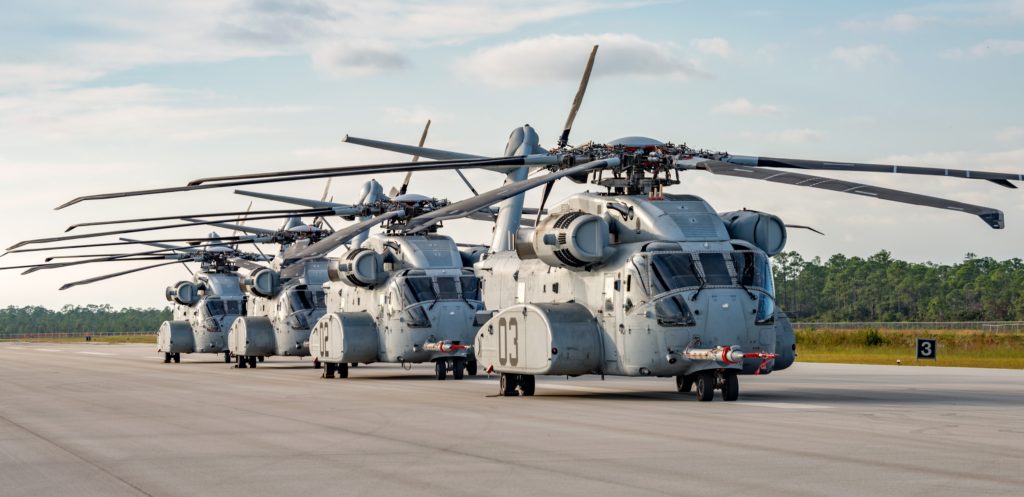
Remaining Contenders
More than ten years later, there are only US platforms left to choose from, as other alternatives (see below) are not politically feasible. Currently, some German officials support the larger CH-53K as it would allow growth for future missions. Others are pushing for the CH-47, which in their opinion is ‘battle-tested’, widespread and probably cheaper.
What definitely is a significant difference is that the CHINOOK has a much higher loading height through the rear ramp due to the tandem rotor without tail rotor shaft. The loading height is more than five metres, which is not only higher than that of the KING STALLION (2.4 metres), but also higher than that of any other conventional rotorcraft. The CHINOOK can also use all 100% of its engine power for vertical lift, while his competitor – again like all normal helicopters – diverts 10 to 15% of the power for the tail rotor drive. So, both have their merits.
The KING STALLION
The latest sibling of the initial HH-53 “Jolly Green Giant” (its 1960s nickname, after a mascot of the “Green Giant” vegetable company) is designated CH-53K or KING STALLION and will be of the same size and shape as its predecessor. The CH-53E SUPER STALLION from 1980, of which the Navy and the USMC acquired 177, was the first with three engines. With its now upgraded GE38-1B engine, it will be able to externally lift 27,000 pounds (12.2 tonnes), which is a more than three times higher load carrying capacity. The US Navy wants to buy up to 200 KING STALLION for the US Marine Corps. Allegedly, this was a prime motivation for Lockheed-Martin’s US$9Bn acquisition of Sikorsky Aircraft from United Technologies Corp. back in 2015.
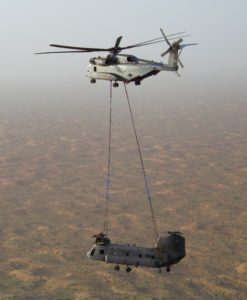
The KING STALLION had its first flight on 25 October 2015, and in May 2018, the USMC received the first helicopter. The current budget called for the buying of 61 helicopters until 2023, based on an annual procurement rate rising from US$1.3Bn last year to US$2.3Bn. However, in its next five-year plan for FY 2020-2025, the USMC is now tentatively proposing to buy 10 fewer of these ‘heavies’ than planned and to reduce procurement funding over that period by as much as US$1.2Bn. At the moment, only six CH-53Ks for US$718Bn are included in the President’s FY 2020 budget presented in February 2019.
Some say there is a connection between this reduction and the first results of the test programme, which so far has reached almost 1,500 flight hours. Obviously, flight testing performance was not as satisfactory as anticipated as technical problems were either discovered belatedly or not sufficiently resolved.
It is, therefore, likely that the test programme will miss the major milestone of the IOC
(Initial Operational Capability, defined by the USMC as four aircraft that can be operated with trained crews and maintainers) in December 2019. According to Naval Air (NAVAIR) Systems Command spokesman Greg Kuntz and the US Office of the Director, Operational Test and Evaluation (DOT&E) on 31 January 2019, “the Programme Office is planning a major schedule revision that will include solutions to technical challenges such as tail rotor and drive shaft defects, airspeed anomalies, overheating of main rotor dampers and late deliveries of newly developed parts”.
A noteworthy problem was the exhaust gas recirculation. Currently, exhaust-gas is being sucked in again, which limits the service life of parts such as the main rotor gearbox. However, Sikorsky CH-53K Programme Director Bill Falk said in January 2019 that “the current technical problems are solvable and solutions are in progress. For example, regarding the problem of exhaust gas recirculation discovered during flight testing, Sikorsky engineers are confident that they have a solution to solve the problem with minimal impact on ongoing flight testing and production. We have completed prototype designs, 3D-printed prototypes and identified suppliers for rapid prototyping. And we expect a solution to be integrated into production aircraft in 2019.”
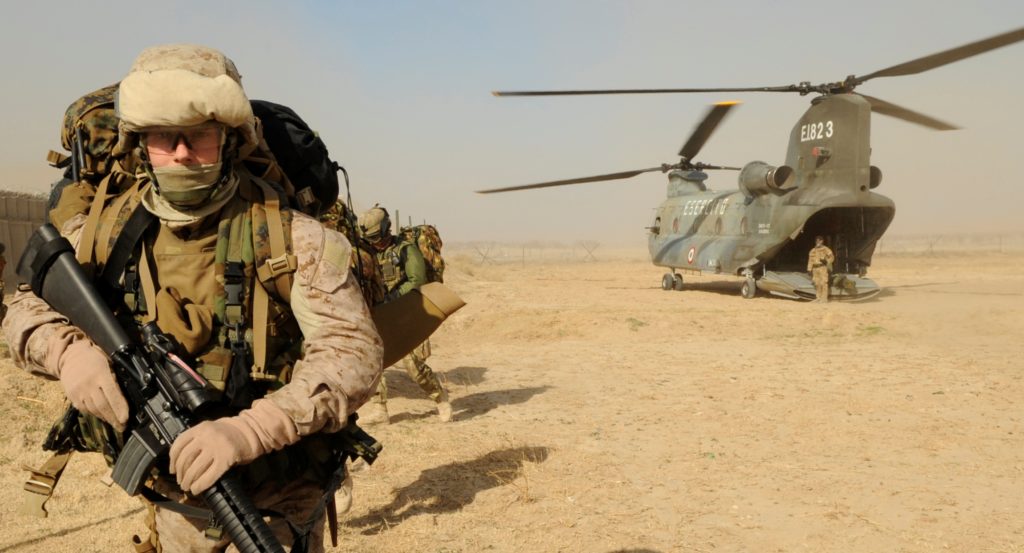
While the postponement is also due to a lack of sufficient funds to complete the System Development and Demonstration (SDD) phase within the original timeframe, due to the technical problems that have extended the SDD beyond the original forecasts, the USN has not yet formally established a new IOC date. Current forecasts expect IOT&E (Operational Tests) to start in early 2021.
Should Germany decide in favour of the KING STALLION, the highly competent and charming son of the legendary founder and pioneer Igor Sikorsky, Sergey (94), said at the ILA Air Show 2018 in Berlin that Lockheed-Martin (with Sikorsky) has the following German industrial partners on board: Rheinmetall, which will lead the local efforts – MTU Engines, ZFL, Autoflug, Hydro, Rockwell-Collins Germany, Jenoptik, Hensoldt, Liebherr and Rohde & Schwarz.
Besides, RH-53D deminers in Iran (with questionable operational readiness), 33 CH-53D YASURs in Israel and 11 MH-53J in Japan and the predecessor of the KING STALLION, which is well established and appreciated in Germany, no other European country acquired the large Sikorsky rotorcraft – with one rather unexpected exception. In September 1970, Austria surprisingly acquired two of the so-called S-65OEE. This was a downgraded S-65C-2, very similar to what the USMC introduced at the time. Several flood and mud disasters in remote areas in 1965 and 1966 had highlighted the need for eight-tonnes lifting capability, and it was originally planned that each of the nine Austrian provinces would finance a heavy lorry. When the Socialists assumed office the following year, nothing was ever heard of these ambitions again, and the two heavy lift helicopters of 2nd Sqn Helicopter Wing 3 in Linz-Hörsching were surprisingly sold to Israel for a paltry €4M and flown out overnight on 14 May 1981.
This move was a result of Chancellor Kreisky’s Middle East policy, although he later officially declared to parliament that the two had become too expensive to maintain. What is true is that Israel’s IAF has been searching to this day for crash replacements for its very similar and worn-out YAZURs it has been using since 1969. One of the two former Austrian aircraft allegedly crashed in 1996, while the other is still in IAF service as 065, although it has been significantly upgraded to the YASUR 2025 standard.

According to the original plan, the type should have been in service until 2010 but it has since been upgraded to keep it in service until 2025. According to the IAF, there is no replacement for the old YASUR; there are no powerful VTOL aircraft capable of performing these missions. While Israel is already looking at the CH-53K, it believes that the US will not be able to export it to allies until a few years after USMC completes the IOC. As far as possible priorities are concerned, however, the US military aid to Israel and an economic case in Germany are not really comparable.
The CHINOOK
The only other competitor to the German MoD’s tender is Boeing’s latest version of the worldwide established tandem-rotor – the CH-47F CHINOOK. Of the 750 CHINOOKs operated by the US during the Vietnam war, about 200 were lost in combat and 500 were upgraded to the -D configuration. The author has visited the production line in Philadelphia shortly after the new production of F-models and the upgrade of up to 300 older D-versions to that standard had begun. In the meantime, production has risen to an astonishing four to six aircraft per month, divided between newly built CH-47s for the US Army and overhauled CH-47Ds. In the end, the US forces will operate 473 CH-47F. Production for 15 CHINOOK ordered by India is under way as well, with a first helicopter delivered in February 2019 to Mundra Port in Gujarat and ferried to its future base at Chandigarh. The subcontinent is the latest addition to the basket of 20 operators worldwide and six in Europe (UK, Netherlands, Italy, Spain, Turkey and Greece), with a total of 900+ airframes flying worldwide.
The CHINOOK – the word designates a native Indian tribe from today‘s Washington state – marketed today by Boeing Rotorcraft has little to do with the aircraft that made its first flight as the YCH-1B by Boeing-Vertol in September of 1961. Improved and more powerful versions followed since its introduction, with the CH-47D being one of the most substantial versions. It first entered service in 1982 and improvements included upgraded engines, composite rotor blades, a redesigned cockpit to reduce workload, improved and redundant electrical systems and avionics and the adoption of an advanced flight control system. Next to the Lockheed C-130 HERCULES, it is one of very few aircraft developed in the early 1960s that have remained in production and frontline service for more than 50 years. And the CHINOOK has not stopped evolving since Boeing is developing a new standard called Block-II with increased capabilities to the F-model. And another re-evaluation is to begin from 2023 on and might even be followed by a Block-III. In that case, the design would still be around by 2060, which would make it more than 100 years!
Today, the CH-47F avionics is, of course, ‘state of the art’, with full screen MFD cockpits. The autonomy and power handling of the CHINOOK have also increased considerably. Block II includes the integration of new rotor blades, which increases its load capacity. The bow and stern area of the hull will be replaced and reinforced by new structures to accommodate the heavier and more powerful engines for Block III. The three lateral fuel tanks are replaced by a single tank capable of holding more fuel, which increases the autonomy of the aircraft. And in keeping with the rapid progress in this segment, avionics will also need to be modernised.

The standard Block-II can be offered for export from 2025. This date should coincide with the start of Block III development when the US Army confirms its announced intentions. The objectives of this modernisation remain the same as for Block II – to increase load-bearing capacity and autonomy, improve avionics and develop interoperability. Boeing has already begun flight testing of the new rotor blades. This year three aircraft are expected to be converted and used as prototypes for Block II. Once approved, 25 to 30 Block IIs can be shipped out annually out of Philadelphia.
Of course, Boeing has also named its German industrial partners, should it win the contract. On board are ten companies such as CAE, Diehl, Honeywell, Liebherr, Reiser, Rockwell Collins Germany (also in the Sikorsky ‘basket‘) and Rolls-Royce Germany. And, according to Chuck Dabundo, Boeing’s Vice President Programme Manager of Cargo Helicopter programmes, there is potential for more to join. Last year, it was also announced that Boeing and Rohde & Schwarz had reached an agreement to integrate Rohde & Schwarz’ next-generation software-defined airborne radio (SDAR) into the flight systems of the CH-47F/G CHINOOK helicopters.
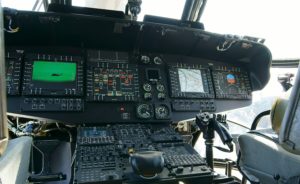
Dr. Michael Haidinger, President of Boeing Germany, explained that Germany “is looking for a low risk standard solution with support, maintenance and training in Germany”. Depending on Germany’s requirements, both the CH-47F and the Extended Range MH-47G will be offered. However, air-to-air refuelling will be included in both variants. Support and maintenance will be carried out in Germany, as well as pilot and crew training with partner companies. With production up and running, Boeing Sikorsky is well ahead in terms of delivery times. Boeing is well positioned to deliver the 40 to 60 new helicopters between 2023 and 2031.
As mentioned, there are six European operators of the CH-47 series and some of them replace them or invest into modernisation, life-extension and upgrade steps. The Netherlands is pursuing both paths, with 14 new CH-47F acquired through FMS in 2016 and with an agreement with Boeing and the Netherlands MoD signed in December 2017 for upgrading six RNLAF CHINOOKs to the latest F-model configuration, ensuring commonality of systems for their entire fleet of 20 F-model CHINOOKs. Deliveries of the six modernised CHINOOKs equipped with a ‘Common Avionics Architecture System‘ cockpit and an integrated ‘Digital Automatic Flight Control System‘ are planned to begin in 2021. Programme Manager Colonel Koen van Gogh explained “Ever since their introduction in the mid-1990s, the CHINOOKs have been continuously involved in almost all of our missions abroad, but also in disaster relief operations and in domestic support. They are truly versatile workhorses of our Defence Materiel Organisation (DMO). It is responsible for providing the Dutch armed forces with the best equipment money can buy, and our troops deserve that. And that upgrade to a common configuration will improve operational effectiveness, maintenance, and affordability.”
Turkey is another NATO country acquiring new CHINOOK airframes. In 2011, Turkey signed an agreement with Boeing on the purchase of 11 CH-47F helicopters, with a first batch of six helicopters for US$400M delivered until 2016. In 2015, Turkey placed a follow-on-order for a further five CH-47F. Assembled in the US and in Izmir, the purchase of these helicopters was processed under a US government FMS contract for US$3.4Bn. In August 2018, the Turkish Presidency of Defence Industries announced that it had received the second batch from the US in spite of the ongoing crisis surrounding the delivery of F-35 jets to Turkey. Four of the CHINOOK helicopters in the second package are used by the Special Forces and one will be given to the MoD apparatus.
Since 1962, the Spanish Army Aviation (Fuerzas Aeromóviles del Ejército de Tierra) operates a fleet of 17 CHINOOKs. Between 1982 and 1994, they were upgraded to the D-standard and recently, Boeing has announced that it will upgrade these helicopters to the CH-47F standard. The decision by the Spanish MoD to modernise the CHINOOKs was taken in September 2018, for a sum of €820M. According to Boeing, modernisation will include the integration of digital flight controls and new avionics as well as modified internal and external lifting/slinging capacities. Meanwhile, these aircraft are operated by the 5th Transport Helicopter Battalion of the Spanish Mobile Air Forces, who is responsible for logistical support to combat units. The first modernised CHINOOK is to be delivered in 2021. “The CHINOOK is a versatile aircraft flown by eight NATO nations, including Spain,” said Chuck Dabundo. “With this contract, Spain’s CHINOOK crews will enjoy the platform’s current technology and capability, while the country gets an affordable upgrade that builds on its existing and well established H-47 investment.”

In the 1980s, NATO partner Greece bought 10 CH-47C, nine of which were later upgraded to the CH-47D standard. In 2015, Greece bought three second-hand CHINOOK from the US National Guard. In 2016 and 2017, the Greek government purchased 10 former US Army CH-47D CHINOOK helicopters and had them repaired, modified and painted by Summit Aviation at Summit Airport in Delaware. All in all, Greece has a total of 15 DG/SD-helicopters in operation at Megara Airport
In Italy, 38 C-models were assembled locally for the Army Aviation (Aviazione dell’Esercito). Two were delivered in 1973 for evaluation. Subsequently, 26 airframes were upgraded to the CH-47C-Plus standard, with fibreglass rotor blades and T55-L-412E engines. In 2009, 16 new CH-47F were ordered by the General Directorate of Air Armaments to replace the CH-47C, with deliveries planned for between 2014 and 2017. AgustaWestland Italy is the prime contractor for systems integration, final assembly and aircraft delivery, and the first two helicopter were handed over on 2 October 2014 at Verigate. Furthermore, the CO.FS (Joint Forces Command for Special Forces operations) greenlighted the acquisition of four CH-47F in the ER (Extended Range) variant to equip the 3rd Army Special Operations Helicopter (REOS) ‘Aldebaran‘ Regiment. The version chosen for the 3rd Regiment will be the same as the Canadian one, with larger standard fuel tanks and larger side sponsons. This modification will make it possible to greatly extend the range of the helicopter, without having to use an internal fuel-tank kit, thus avoiding sacrificing precious space for the transport of material and men. In addition, the request for the installation of an in-flight refuelling probe was forwarded to Boeing.

No Real Western Alternative
Although it is not a real competitor for the German STH replacement programme, another western heavy lift helicopter has to be mentioned: The Sikorsky H-92 was developed on the basis of the civilian S-92 HELIBUS of 1998. With a MTOW of 12+ tonnes it is not as powerful as the CHINOOK and the KING STALLION. The Sikorsky H-92 has so far only found one customer with the Canadian naval helicopter CH-148 CYCLONE.
Unfortunately, since 2004 the programme has developed into a textbook example of what not to do in a military acquisition. While Canada’s 50-year old SEA KING fleet aged and deteriorated to dangerous levels, political pettiness and lack of concern turned a straightforward off-the-shelf buy into a 25+ year long odyssey of cancellations, lawsuits, rebids and so on. Eventually, the Canadian military settled on Sikorsky’s MH-92 SUPERHAWK, which will serve from the decks of Canada’s naval ships and bases. It is a larger derivative of the ubiquitous H-60 family that comprise most of the USN’s current fleet and makes heavier use of salt/rust-proof composite materials.

It also sports uprated GE CT7-8C engines rated at 3,070 hp (2,290 kW), a rear ramp and other features that place it slightly ahead of Europe’s NH/NFH-90. The H-92 can carry up to 3,030 kg of fuel in standard self-sealing fuel tanks, while an in-flight refuelling probe allows in-air refuelling for extended range flights. A 17 cubic metre cabin is fitted with a cargo handling system with a centreline 1,814 kg/4,000 pound capacity cargo winch, floor rollers and cargo tie-down points. A six foot-wide aft ramp allows easy and fast loading and unloading of cargo and troops. A 272 kg/600 pound capacity hydraulic rescue hoist can reportedly be installed if necessary, while a Telephonics APS-143B radar, a HELRAS active dipping sonar system supplemented with launched sonobuoys and a Star SAFIRE-III day/night IR/ElOps surveillance turret offers a good mid-level sensor set. In 2014, the S-92 was selected as the future MARINE ONE flying the US-President as the VH-92A. 21 of them are on order with the first flight witnessed in 2017.
Eastern Heavy Lifters

Due to the current climate between the West and Russia, it is not subject for considerations by European countries but with a length of 40 metres and a rotor-diameter of 32 metres. By far the largest or heaviest-lifting rotorcraft anywhere, of course, is the Russian Mil-Mi-26 (NATO designation HALO). Able to lift a fully loaded CH-53, it first flew in 1977, can transport more than 25 metric tons or carry 82 combat-ready troops and a range of combat vehicles. The HALO still holds the world-record for the heaviest mass lifted to 2,000 metres (6,562 ft) – 56,768.8 kilogrammes (125,153.8 lb) on a flight in 1982. About 20 HALO are in service with the Russian Air Force and Border-Guard – 14 HALO were exported to Algeria, China, India, Jordan, Mexico, Peru, and Venezuela. A civilian Mi-26 was once leased by the US military to lift-out a couple of damaged and crippled CH-47s and UH-60s from various spots in Afghanistan. On 19 August 2018, the Russian industrial conglomerate ROSTEC, the parent company of ‘Russian Helicopters‘, announced the first flight of a prototype of the latest military version. As the original engine manufacturers Ivchenko and Motor Sich are now in Ukraine, the Mi-26T2V has gotten new Aviadvigatel PD-12V engines and features the NPK90-2V avionics suite, which allows the helicopter to operate day and night in automatic mode. An NVG-friendly cockpit is fitted with MFDs, which considerably enhances the aircraft’s controllability and allows to eliminate the flight engineer and navigator stations, while crew protection has been increased with hardened and crash-worthy seats.
The world’s newest addition to the heavy lift sector is a helicopter modelled on the HALO – the Chinese-Russian “Advanced Heavy Lift” concept. This helicopter is also larger than all the others in the West. At IDEX, Viktor Kladov, a high-ranking ROSTEC representative, declared that development contracts “will soon be signed”. What he called “the contract of the century signed with AVIC and its partners” developed in four years of back and forth discussions as a joint venture to develop a new heavy multi-purpose helicopter with a maximum take-off weight of 40 tonnes. Specifications are 15 tonnes payload, a range of 630 kilometres and a maximum speed of 300 km/h. The helicopter will have a maximum lift capacity of 15 tonnes. All this clearly points to the Chinese Military (PLA), which urgently needs more heavy helicopters to increase its readiness in the event of a military emergency, major natural disasters or to support yet another island fortification far off its own coastal waters. PLA’s current helicopter squadrons consist mainly of medium-sized transporters such as the Z-9, Z-20 and Mi-17. The Chinese know the Mi-26T because Beijing leased a number of Mi-26s after the devastating Wenchuan earthquake in May 2008 to transport relief supplies, first responders and injured civilians in Sichuan province. Chinese media welcomed the orange Mi-26s as they flew first aid and heavy earthmoving equipment to some of the devastated villages that could only be reached by air or trail. And, if there is no war or large troop deployment, deployments like these will most likely be the reason that such heavyweights could be much easier to sell to the public and taxpayers than most other military equipment.
Georg Mader is a defence correspondent and freelance aerospace journalist based in Vienna, Austria, and a regular contributor to ESD.




